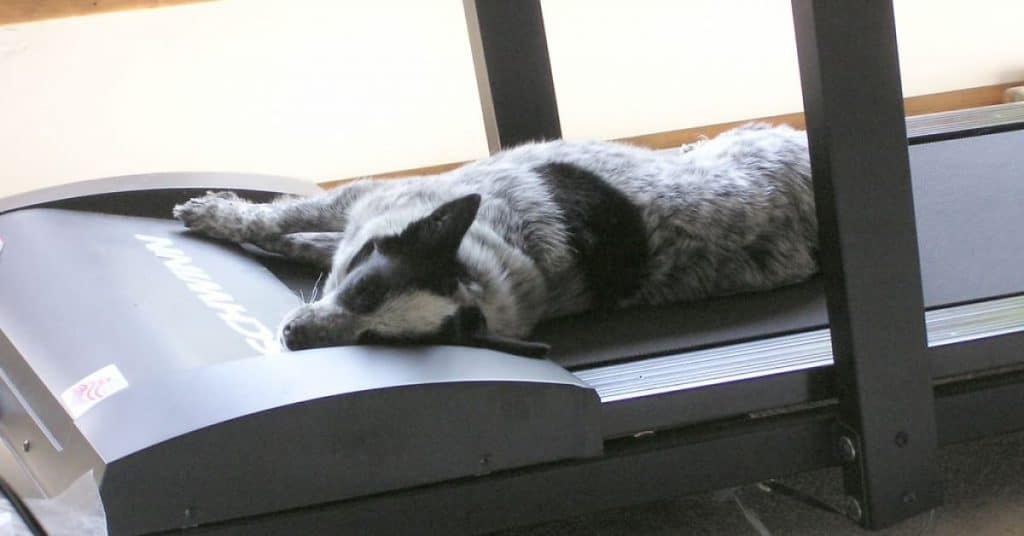Physical activity needs of various dog breeds may differ, but most dogs need plenty of exercise to stay healthy and entertained. Unfortunately, the modern lifestyles of many dog owners prevent their dogs from having enough exercise to maintain their good physical shape.
Luckily, a great solution to this problem is closer than you think. There are all kinds of dog exercise equipment, but dog treadmills have proven to be both accessible and effective at maintaining your dog’s adequate exercise levels. Here are our top 4 treadmills for dogs and a complete buying guide that will help you make just the right choice.
dogPACER LF 3.1 Dog Pacer Treadmill
Editor’s Choice
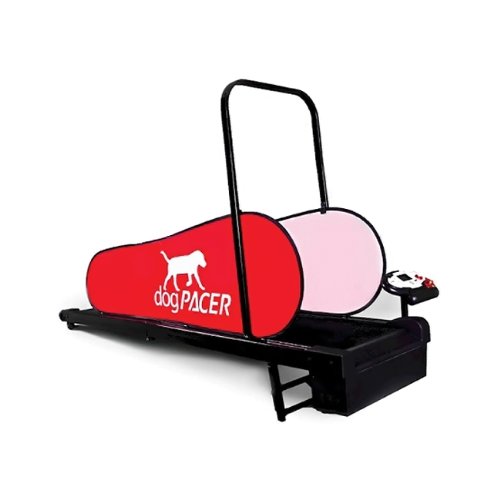
There are many features that make this dog walker treadmill by dogPACER the best option available today. It is designed for dogs up to 180lbs, which means that even the largest dogs will fit conveniently on this doggie treadmill. Moreover, the treadmill features a patented folding design, allowing you to quickly fold and unfold the device for easy transportation.
Other winning features of this dogPACER treadmill for dogs include a super quiet motor and customizable running programs that will let you effortlessly pick the right exercising level for your pup’s shape, age, and weight.
Best for Small Dogs
Go Pet Petrun Pr700 Dog Treadmill
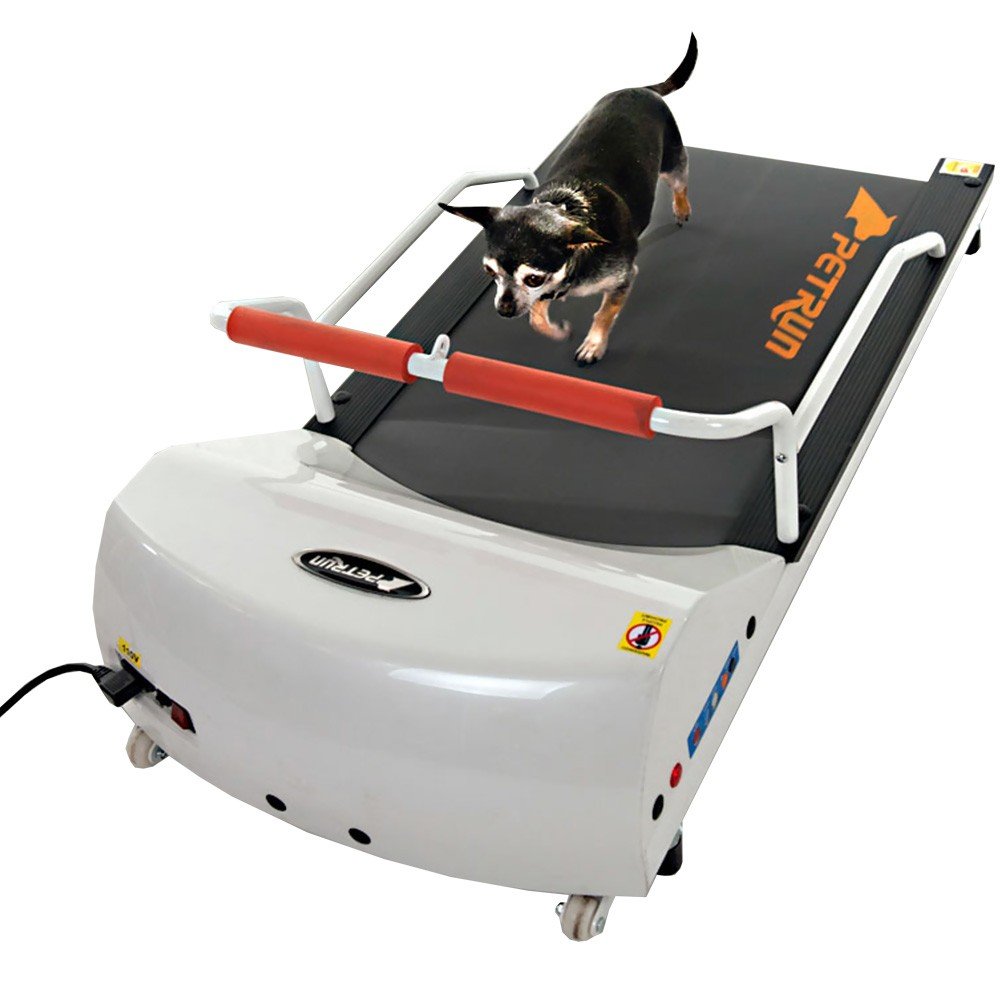
Tiny dogs need lots of exercise too, and this is where the small dog treadmill by Go Pet comes in handy. Designed specifically for dogs under 30lbs, this treadmill will help your pup meet the required level of physical activity without any excuses.
This cheap dog treadmill has a number of features that are guaranteed to win over you and your beloved dog. There is a recessed treat holder, which may be a necessity if your dog needs time to ease into regular training. The quiet motor won’t disrupt the life of your household during exercise, and the sturdy, dog-friendly design will help your dog safely enjoy every workout session. Plus, there are transportation wheels for easily moving this pet treadmill around.
Best for Large Dogs
Dog Runner Large The Ideal Treadmill for Home
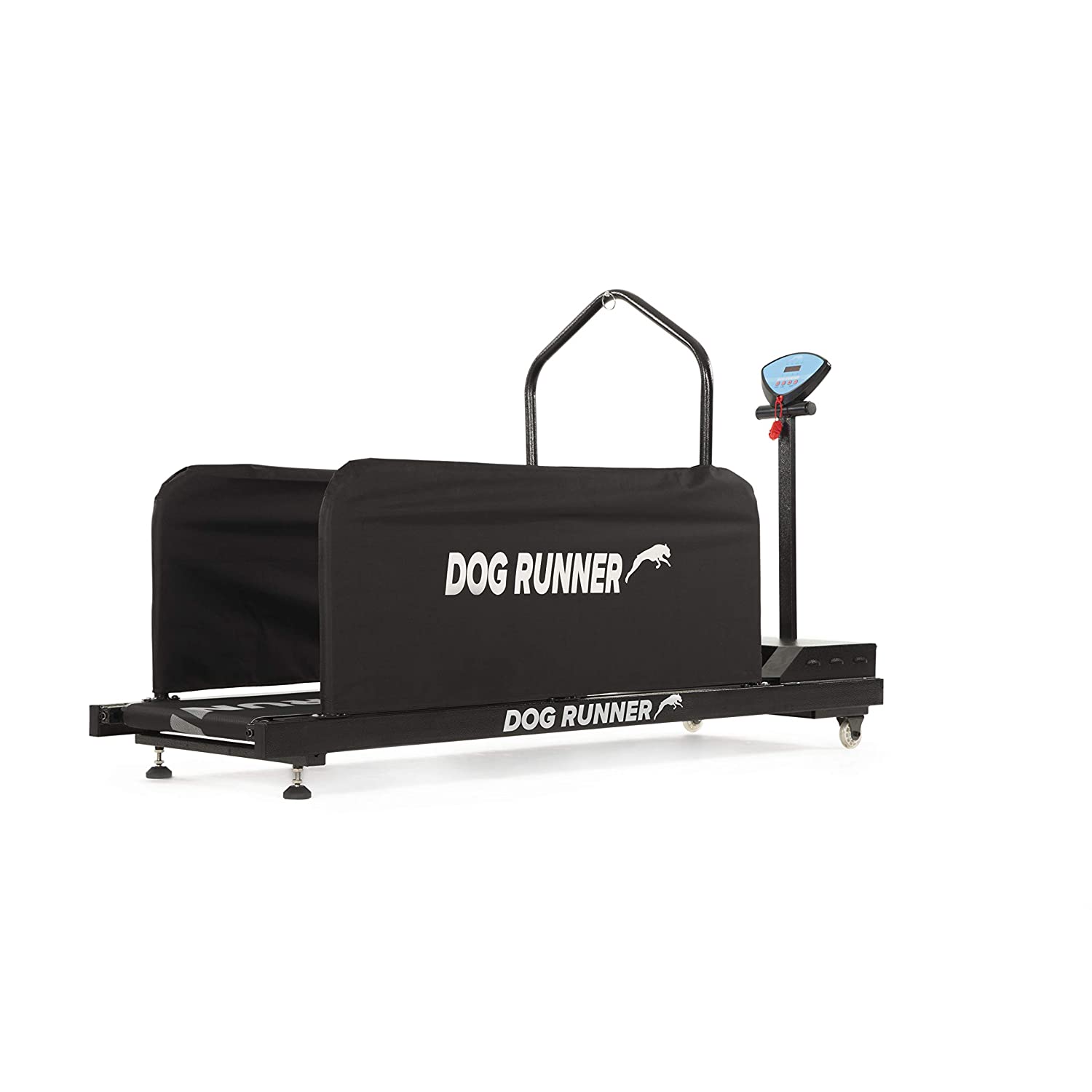
Larger dogs often have special exercise needs. On top of that, a large dog treadmill needs to be durable and extra stable to sustain the weight of your pup. The Dog Runner treadmill meets these requirements with ease and is one of the best options available for large dogs. It can safely accommodate dogs up to 242lbs.
In this dog exercise machine, you won’t find any fancy or high-tech features. Instead, it can become your go-to device for dog fitness and energy management. With adjustable speed ranging from 0,8 to 12 km/h and with several modes to choose from, along with the time, distance, and calorie monitoring capabilities, you can rest assured your dog’s physical shape is in good hands.
Best Dog Treadwheel
GoPet Treadwheel ToySmall
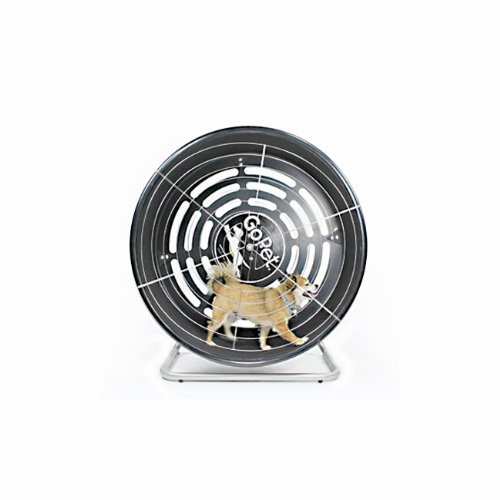
If you have always imagined treadwheels to be exclusively available for hamsters, you will probably be surprised to learn that a dog exercise wheel is one of the hottest types of dog gym equipment you can buy today. The GoPet dog hamster wheel is a great way to keep pups up to 25lbs in shape.
One of the best things about this dog wheel is the fact that it does not need electricity for a running session, which means you can use it both indoors and outdoors. The UV protection will allow your pup to enjoy running even under direct sunlight, and the cushioned matted surface of the wheel will feel extra comfortable for your dog’s paws. The training door will help protect your dog while running and make it easy for your pup to get in and out of the wheel.
How to Choose the Best Treadmill for Your Dog
As the variety of treadmills for dogs is getting bigger and bigger, finding the most suitable dog treadmill for sale becomes more challenging. With our tips, you will effortlessly choose the best dog treadmill for your dog’s needs.
Why does your dog need a treadmill?
The question of whether dogs actually need regular treadmill training is one of the most divisive ones in today’s pet lover community. Some dog owners and veterinarians believe that nothing, not even the most advanced and expensive treadmill, can be an adequate substitute for traditional dog walking. They insist that putting your dog on a treadmill instead of letting him explore the great outdoors is not the best pet owner behavior.
On the other hand, there can be many situations where a treadmill is possibly the only way to effectively exercise your dog and maintain his health. Here are the five most common reasons for you to consider buying a dog walker machine.
- Busy owner
If you have a busy lifestyle, work long hours, or have other commitments that prevent you from walking your dog for hours every evening, a dog treadmill may be the only option to keep your pup exercised. With your dog getting his dose of physical activity by your side every night, you can still enjoy that special connection even without daily walks.
- Adverse weather
In case you live in a climate with frequent harsh weather, which may include snow, rain, strong winds, and heat, then walking your dog every day for hours may not be an option — even if your dog enjoys these walks, the owner will probably not. A doggy treadmill is a great way to ensure your pup still gets the necessary level of exercise no matter what the weather is like outside.
- Excess weight
Dog obesity is becoming more serious of a problem in recent years. Besides putting your dog on a diet prescribed by the veterinarian, you also need to give your dog plenty of exercise to improve his physical shape. With a treadmill, you can start with short and slow sessions and gradually increase the intensity of the workouts, which can rarely be achieved with regular outdoor walks.
- Physical rehabilitation
For dogs who have recently undergone surgery or other serious treatments, dog exercise wheels and treadmills can be the only way to get your dog back to the levels of physical activity he enjoyed prior to the treatments. Together with your doctor, you can design a program for restoring your pup’s mobility without hurting his delicate systems and interfering with the rehabilitation process.
- High-energy dog
If your dog can never get enough physical activity and is always ready for new challenges and adventures, you may eventually grow tired of trying to satisfy the energy needs of your pup. Putting your dog on a treadmill regularly will allow you to catch a break and your dog to enjoy as much exercise as he needs without any destructive behavior.
It’s clear that a treadmill for dogs is one of the best ways to ensure an ideal level of physical activity in any situation. However, there are some downsides to using a treadmill that you should also know about:
- Limited socialization
When walking around the city streets and dog parks, your dog meets many humans and other dogs who can satisfy his socialization needs. With regular treadmill exercises and rare visits outside, your dog’s socialization is limited to you and other members of your household.
- No stimulation
Every visit to the dog park or a stroll around the streets of the city is filled with various experiences for your dog. With lots of things he can see, smell, hear, taste, or interact with, regular walks provide the much-needed mental and sensory stimulation to your pup that can be hardly achieved at home.
- Limited physical activity
The only two things your dog can do on a treadmill are running and walking. Without an opportunity to jump, crawl, roll over, hop, and do other popular dog stunts and tricks, your pooch may eventually feel bored with the treadmill and return to the unwanted behavior you were trying to stop.
So while there is no doubt that a treadmill is a great invention for dog fitness and health, it is important to use it in moderation. Whenever possible, take your pup out for a fun and refreshing walk, and then you will be able to safely substitute the rest of the walks with an intensive treadmill workout
Important features to consider
To make the best possible choice of a dog treadmill, make sure to take the following features into account:
Treadmill size and portability
If you live in a limited space, you will probably not have the ability to keep a dog treadmill out in the open all the time. That is why you will need a folding treadmill that can be safely put away when you are not using it. If your space is not particularly limited but you want to be able to carry the treadmill around the house with you, look for a device with transportation wheels. Finally, pay attention to the weight of the device you are planning to buy — lightweight treadmills are always the preferred option for easy transportation and storage.
Dog size and weight
The size and weight of your dog are, perhaps, the two most important parameters for choosing the perfect treadmill for exercise. The running section of the treadmill should be approximately twice as long as your dog’s length — then your pup will be able to safely run without the risk of an injury.
As for the weight, most treadmills come with specific weight requirements. Putting a heavier dog on a treadmill for small pups may result in the treadmill being permanently damaged. However, the reverse situation is also not ideal: smaller dogs may have trouble achieving the perfect speed on a treadmill designed for larger dogs, which, again, can result in injuries and lack of enthusiasm for an effective workout.
Speed
Most treadmills for dogs come with a variety of speed settings, but you need to pay extra attention to the highest and lowest speed available in the treadmill. Extremely high speed is a great option for young, highly energetic, medium to large dogs who have plenty of stamina to run quickly. However, if you are purchasing a treadmill for an older pup, a dog that is being rehabilitated, or a smaller dog with short paws, then you might consider a treadmill with a low speed setting.
Incline
The incline setting in doggie treadmills can be very helpful for dogs who are trying to lose weight, since higher incline means more calories spent per running session. Older or smaller dogs may not be able to handle a steep incline and require a flat surface for healthy running.
Other features
These three extra features will help you make the best choice of a treadmill for your pup:
- Walls
Running at high speed always carries a risk of falling off the treadmill, which is why the most advanced treadmills come with side walls or other construction elements that prevent your dog from being injured.
- Noise
All doggie treadmills are designed with the comfort of the dog users in mind, which is why most of them have extremely quiet motors. Still, it’s worth taking some time to check the reviews for the model you are considering to confirm that it’s not too noisy.
- Price
Many treadmills for dogs are not budget-friendly at all, but you are still not of options if you want to buy a dog treadmill cheap. Simply think about the features you are ready to give up in exchange for a lower price or consider buying a used device online.
Frequently Asked Questions
Dog and human treadmills look relatively similar, which may give you an idea to use your regular treadmill for exercising your dog. However, there is a variety of reasons not to do it. First, human treadmills have a shorter running track that is not suitable for medium and large dogs. Second, treadmills for humans are normally noisier than their doggy counterparts. Third, human treadmills don’t have walls or rails at an appropriate height to protect the dog from falling off the track.
In most cases, running on a treadmill is a more intensive exercise than exploring the nearby dog park. One running session for your dog should not exceed 30 minutes and you can have up to 2 sessions per day. It’s important to start with shorter sessions and gradually increase their length, as long as it feels comfortable for your pup.
If your dog no longer enjoys his treadmill workouts or never liked them in the first place, you can try encouraging him with dog treats to continue the running session. Some treadmills even come with special treat compartments that your dog can use on his own. Another way to encourage your pup to run is to place his absolute favorite toy in front of the treadmill to give him an extra reason to carry on running.
If your dog is acting anxious around the treadmill and seems reluctant to do the workout, you can start by offering him some treats or a toy to encourage him to continue. If that does not work, you can also feed your dog full meals when he is standing on the running track.
Your instinct may be to set the treadmill to a low speed, but that can cause your dog to hesitate. Instead, you should choose a medium-high speed and put your dog on treadmill, so that your pooch has no time to hesitate and instead begins moving naturally.
Your job is to make the treadmill a normal part of your dog’s daily routine, which means you should never overreact or become too focused on teaching your pup to use the device.
